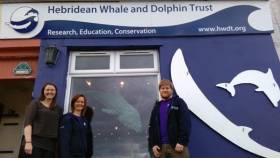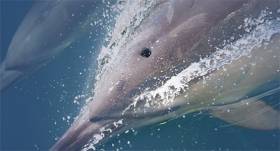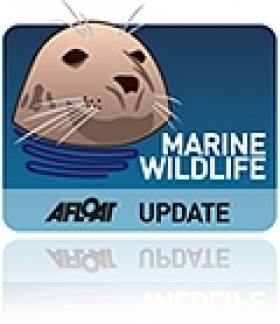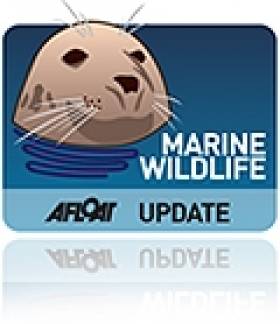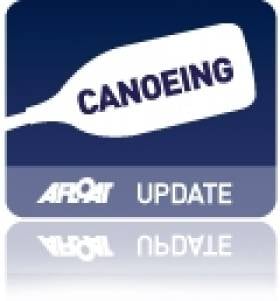Displaying items by tag: Whale
A new marine wildlife visitor centre has been launched in Tobermory on the Isle of Mull by conservation charity Hebridean Whale and Dolphin Trust – to strengthen conservation action for whales, dolphins, and porpoises, and to develop the Hebrides’ appeal as a wildlife tourism hotspot.
The Hebridean Whale and Dolphin Centre on Tobermory’s picturesque harbour front was formally opened this month, and will be a learning, training and volunteering hub, as well as providing a major attraction for visitors, including families and children.
The building’s transformation has been funded as part of a grant of almost £220,000 from the UK Government’s Coastal Communities Fund. The fully renovated and extended centre features information on sightings of cetaceans – the collective name for whales, dolphins and porpoises – interactive exhibitions, displays and a gift shop.
“Our new centre aims to put Mull and the Hebrides even more firmly on the map as a key destination to enjoy and discover world-class marine biodiversity – which in turn will boost conservation, and could bring significant economic and social benefits to the region,” said Alison Lomax, Director of Hebridean Whale and Dolphin Trust.
The centre was recently launched with a celebratory event attended by dozens of guests from across the UK, including conservationists, scientists, volunteers and local businesses.
The trust’s previous shop and visitor centre attracted 26,000 people in 2015 – a figure that Hebridean Whale and Dolphin Trust hopes will now rise significantly.
With Western Scotland’s seas being one of Europe’s most important cetacean habitats, the charity believes that developing sustainable marine wildlife eco-tourism is a major opportunity, as demonstrated by the benefits of white-tailed eagles to the local economies of Mull and Skye.
So far 24 of the world’s estimated 92 cetacean species – including many national and international conservation priority species – have been recorded in the region, and fascinating new discoveries about these populations are constantly being discovered.
The Coastal Communities Fund has also enabled the trust to carry out an innovative Sea Change project across the Hebrides over the past two years, to strengthen people’s connections to the sea in remote island communities. This has involved engagement with thousands of people, through roadshows, community visits, liaison with wildlife tourism businesses, and dozens of events.
Responsible whale watching, WiSe (Wildlife Safe) accredited, training has been provided for 23 tour boat operators, while local people have been able to develop skills through the trust’s Community Sightings Network – through which people can report sightings of cetaceans, helping to map their distribution.
Sea Change has been carried out on Mull, Coll and Tiree, Islay and Jura, Colonsay, Barra, Small Isles (Eigg, Muck, Rum, Canna), Mallaig and Arisaig, North and South Uist, Harris, Lewis, Gairloch and Skye.
The Coastal Communities Fund has also funded a refurbishment of the trust’s research yacht, Silurian, aboard which marine scientists and volunteers conduct surveys monitoring cetaceans each year. More than 90,000km of Hebridean seas have been surveyed and over 18,000 individual cetaceans recorded so far – significantly extending scientists’ knowledge and understanding, and informing long-term conservation initiatives.
Paying volunteers are being recruited for the trust’s 2016 expeditions onboard Silurian, working alongside marine scientists. For details, email [email protected], call 01688 302620 or visit www.hwdt.org.
The Coastal Communities Fund was created to direct regeneration investment to seaside towns and villages to help rebalance local economies, reduce unemployment and create work opportunities for local young people.
Following our earlier photo from Baltimore Sea Safari of a Humpback Whale breaching in spectacular fashion off the West Cork coast, Kerry reader Brian O'Sullivan (of marine firm O'Sullivan's Marine) has sent Afloat.ie this latest image of further breaching off Fenit yesterday.
Marine Traffic Pressures on Scotland’s Cetaceans to be Studied Using Navigation Safety Technology
Electronic navigation safety technology is to be used to study the potential impacts of marine traffic on whale, dolphin and porpoise species off western Scotland in a new season of research expeditions launched by Hebridean Whale and Dolphin Trust this week.
For the first time, scientists and trained volunteers onboard the conservation charity’s specialized research yacht Silurian will use an Automatic Identification System (AIS) transponder to collect detailed data on other vessels’ movements. This will be combined with sightings and underwater acoustic monitoring of cetaceans – the collective name for whales, dolphins and porpoises – to gain new insights into how species are affected by ships’ movements and noise.
AIS – an automatic tracking system that electronically identifies and locates nearby vessels, continuously transmitting details of their identity, position, speed and course – is more commonly used in navigation safety, allowing ships to ‘see’ each other in all conditions.
With marine traffic from a large range of industries growing, known threats or pressures for cetaceans from shipping include ship-strikes – in which vessels accidentally hit whales – and noise pollution from poorly designed or poorly maintained vessels, which can mask out whale sounds used for communication and navigation.
Dr Conor Ryan, Hebridean Whale and Dolphin Trust Science Officer, said: “This innovative approach provides us with an opportunity to enhance our long-term research, which is providing unprecedented insights into the distribution and range of cetaceans in Scotland’s seas, as well as the challenges they face – including the unintentional consequences of human activities.
“The Hebrides may seem like a wilderness, but human impacts on the marine environment are significant – and likely to increase with expansions in marine industries, such as aquaculture and renewable installations. Strengthening scientific understanding is crucial if we are to help industries ensure that their impacts on Scotland’s remarkable whales, dolphins and porpoise populations are minimal.”
The new AIS transponder on Silurian will also allow closer public engagement with the trust’s research expeditions. By using the research vessel’s unique Maritime Mobile Service Identity (MMSI) number 232004280, people will be able to follow Silurian’s progress around Scotland’s west coast in real-time via www.hwdt.org.
Equipping Silurian with AIS technology has been made possible by a grant of £94,000 from the UK Government’s Coastal Communities Fund. This grant has also funded a major refurbishment of the yacht, including an environmentally friendly and long-lasting copper coating for the hull that will ensure the vessel remains seaworthy for the next decade, alongside other activities.
Hebridean Whale and Dolphin Trust – based in Tobermory on the Isle of Mull – is recruiting paying volunteers for its surveys. Between May and October, there will be 12 separate expeditions, each lasting between one and two weeks. This includes two ‘Teen Teams’ reserved for 16-17 year olds.
These volunteers will work and sleep on Silurian, receiving specialist training and working with scientists – conducting visual surveys, acoustic monitoring, and cetacean identification through dorsal fin photography. They will also be able to develop sailing and navigation skills as they visit some of Britain’s most remote and wild corners.
Silurian has been the platform for Hebridean Whale and Dolphin Trust’s unique research programme since 2002, welcoming aboard over 60 volunteers annually, surveying tens of thousands of nautical miles and logging every cetacean encounter made. This year, the yacht will welcome her 800th volunteer aboard. The yacht is also used as a floating classroom for marine conservation education for schoolchildren and students.
Western Scotland’s seas are one of Europe’s most important habitats for cetaceans with 24 of the world’s estimated 92 cetacean species recorded in the region to date. Many of these are national and international conservation priority species.
As well as strengthening knowledge about cetaceans and contributing to recommendations to safeguard them, the trust’s surveys are important because cetaceans are apex predators at the top of the marine food web, and so can act as indicators of the marine environment’s overall health.
The 2016 surveys depart from Tobermory on the Isle of Mull, Kyle of Lochalsh or Ullapool. The new addition of Ullapool as a rendezvous point will allow the trust to carry out more surveys in the remoter corners of its study area. Areas covered depend on the weather but will range from Mull of Kintyre in the south, Cape Wrath in the north and St Kilda in the west.
Participation costs cover boat expenses, accommodation, training, food and insurance, and support the charity’s research. For details, email [email protected], call 01688 302620 or visit www.hwdt.org.
#orca – Crews from commercial and Royal Navy vessels have started training for the Orca Ocean Watch Week, an initiative by the whale and dolphin conservation charity ORCA, that is being launched at Portsmouth International Port this month.
Between 25th July and 2nd August bridge crews are being asked to report all sightings of whales, dolphins and porpoises as they sail to and from Portsmouth International Port. The records they produce will help ORCA develop the clearest picture yet of just where the much loved marine mammals are living.
The enthusiastic team from ORCA have spent time training crews from a wide variety of operators, including the banana boats that come and go on a regular basis from the Caribbean and Central America. They've also spent time with the Royal Navy, briefing crews from Portsmouth based vessels.
The Royal Navy ships HMS Smiter, HMS Puncher, HMS Explorer and HMS Trumpeter will be sailing through the English Channel, down into the Northern Bay of Biscay and up into the Baltic Sea. These ships are among 11 vessels contributing to the activity from the 1st Patrol Boat Squadron that are operating all over Western Continental Europe and the British Isles.
Lieutenant Commander Phil Houghton of the 1st Patrol Boat Squadron said, "The Royal Navy and in particular 1PBS are delighted to be able to participate in OceanWatch 2015 and do what they can to support the better appreciation of the complex and vulnerable marine environment in which we operate. Only by understanding the animals and habitats around our local waters can we provide the appropriate protection for them."
Orca Ocean Watch Week will be launched on Monday 20th July by television wildlife expert Nigel Marven. Nigel will be joined at the new passenger terminal at Portsmouth International Port by a 50 foot, life-sized model of a blue whale, and school children eager to learn more about the variety of wildlife in the seas off Portsmouth.
By the time Ocean Watch Week is underway ORCA will have trained crews from over 20 vessels, including ferries, freight ships, cruise liners and small ships.
If you're interested in spotting these fantastic animals yourself, Brittany Ferries and ORCA offer Whale Watching mini cruises from Portsmouth, an increasingly popular trip across the Bay of Biscay, which is one of the most important habitats for whales and dolphins on the planet. ORCA is also working with operators at other ports along the South Coast and Scotland, attempting to get the widest coverage possible for its important survey.
Inflatable Whales Pop up at Portsmouth International Port for Marine Wildlife Festival
#portsmouthwhales – It's not often children get the chance to put their head in the mouth of a shark, but that's just one exciting adventure they can have at Portsmouth International Port's Marine Wildlife Festival in February.
It won't be a real shark, of course, but one of 13 life sized inflatable models of whales, sharks and dolphins that will be on display in the terminal building. The biggest is 42–feet long, that's 13 metres of whale that you can stand next to. Four will be hanging from the ceiling.
The 'pop up' exhibition opens on the 11th February, with classes from schools all around Portsmouth already booked to come and take part in a "Whale Workshop". Experts from marine wildlife charity ORCA will be taking lessons, with students learning all about the whales, dolphins, porpoises, sharks, seals and turtles that can be found on a Ferry crossing from Portsmouth International Port. Passengers and locals can also come and visit at any time during the four day long exhibition.
Whale watching is becoming a popular holiday pastime, with people paying thousands for trips around the world. Yet few realise they can see a huge variety of whales and other species when sailing from Portsmouth to Spain as part of a holiday or other trip. This is because the ferries travel through the Bay of Biscay, which is a whale and dolphin hotspot thanks to the variety of depth ranging from 200 – 4,999 metres deep and the abundance of food that suits many different species. This includes the deep diving Sperm Whale and Cuvier's Beaked Whale, making it a perfect spot for passengers to go looking for these magnificent creatures.
Martin Putman, Port Manager of Portsmouth International Port, said 'Since Brittany Ferries launched its whale watching mini cruises a few years ago we've become known as a gateway port for seeing whales, dolphins and other beautiful marine mammals. Anyone heading off on holiday to Spain has the chance of a memorable encounter, and this incredible Marine Wildlife Festival gives a great idea of what you might see."
ORCA has been working hard with Brittany Ferries for 10 years, with wildlife officers onboard the 'Pont Aven' and 'Cap Finistère' recording sightings of Marine wildlife. The charity is always keen to share its knowledge with passengers, helping them to understand more about what is in the sea around them.
Anna Bunney ORCA Community Wildlife Officer said, "People don't fully appreciate how accessible a wide variety of species is right on our doorstep. There's no need to spend big money to see whales when it's often an added bonus when travelling from Portsmouth International Port. We're delighted to be a part of the Marine Wildlife Festival, bringing this rich variety of creatures to life inside the terminal building."
On display will be life-size models of a 13m long female Sperm Whale, 8m Minke Whale, 8m Basking Shark, 6m Pilot Whale, 6m Orca Whale, 3m Orca Whale Calf, 3m, Risso's Dolphin, 3m Bottlenose Dolphin, 2m Common Dolphin, 2m Striped Dolphin, 1.5m Harbour Porpoise, 2m Grey Seal male, female & calf, and a 2m Leatherback Turtle.
There will be one more loveable whale also in attendance. Pip, Portsmouth International Port's cuddly human sized mascot, will be making an appearance for photos with young children and families off on half term holidays.
Kayakers Hitch A Ride on Back of A Whale
#kayakingwhale – Youtube footage captures the moment two kayakers, a father and daughter were lifted clear out of the water after a whale surfaced underneath them.
The two were paddling in the Atlantic Ocean off the coast of Puerto Madryn, Argentina, when they spotted two whales swimming nearby.
One of the kayakers had a camera and was able to record as the whales turned around and approached their kayak, before suspending them on its back.
The father jokes: "Look, it's coming over here, it's angry with you.
"It's coming to bite the paddle. Terrible, terrible, we're on top of the whale!"
The whale lifted the kayak out of the water for a few seconds, before sinking back below the waves and swimming away.
The footage, posted on YouTube by user gisela6652, has already received nearly 800,000 views online.
Lifeboat Frees Whale Tangled in Lobster Pot
Lifeboat crew at Tramore RNLI were called out this morning to help assist a whale which had become tangled up in lobster pots. Working alongside an inshore fishing vessel, the two crews worked together to free the mammal.
The lifeboat was launched with around 11.30am after a local fishing vessel reported what they believed to be a whale caught up in lobster pots a quarter of a mile out from shore. When the lifeboat arrived on scene they had to wait some minutes for the creature to surface.
On closer inspection it was discovered that the rope holding some lobster pots together had become snagged in the mammal's mouth and it was turning around in the water repeatedly, attempting to free itself.
The lifeboat worked alongside the inshore fishing vessel, which had an onboard winch, to try and cut the rope free from the mammal's mouth. At first the lifeboat crew tried to take hold of the rope but they were being dragged by the mammal. This continued when they passed the rope onto the larger fishing vessel.
It was then the mammal was hoisted onto the winch of the inshore fishing vessel and the rope was cut free. The lobster pots where then hauled onboard and the mammal on becoming free from the pots calmly swam out to sea.

Commenting on the callout Tramore RNLI crewmember Tom McConnell said, "This was a huge creature. We had to be extremely cautious and work carefully with the other vessel to free it. We felt that one wrong move and we could be flipped over in our inshore lifeboat. We had asked our colleagues in Dunmore East RNLI to be on standby with their all weather lifeboat but thankfully the whale was freed and able to return the deeper waters."
#VOLVO OCEAN RACE - The incredible finish of the latest leg of the Volvo Ocean Race wasn't the only drama on the high seas for one competing team.
Just days before CAMPER with Emirates Team New Zealand had the misfortune of stalling metres from the line in Lisbon on Friday night, they were involved in a near-miss with a whale in the North Atlantic, as the UK's Mirror reports.
The video above captures the team working quickly to alter their course to avoid the marine giant on their port side at a speed in excess of 20 knots.
It's that kind of quick thinking that separates the good from the great who take part on this round-the-world odyssey across the planet's toughest seas.
The CAMPER team currently lies fourth in the overall standings, 21 points behind new leaders Groupama.
Whale Gets Third 'Best Company to Work For' Accolade
#BUSINESS - Water systems firm Whale has featured in The Sunday Times' Best Small Companies to Work For list for the third year running.
The 2012 edition of the list sees the Bangor-based company - and the only Northern Irish representative - rise 19 places to number 77.
Whale was particularly commended for looking after the wellbeing of its staff, its overall ranking of eighth place reflecting the faith in managing director Patrick Hurst and the employees trust in the “sound capabilities” of the leadership.
Patrick Hurst commented: “To be listed again in 2012 is just fantastic for all the team at Whale. Our employees and their attitude and loyalty is what defines the business and is core to its continued commercial success.
"The Whale team in the are a credit to the company and themselves. They have all worked hard together to continually maintain the quality and introduce innovative, market leading products."
Whale (Munster Simms Engineering Limited) is a key player in the leisure marine, recreational vehicle, shower drainage and industrial markets. The company specialises in the design and manufacture of water, waste and heating products including manual and electric freshwater, bilge and waste pumps, Quick Connect plumbing systems, faucets, showers, space and water heaters, and accessories.
Omey Island Whale Buried at Sea
#MARINE WILDLIFE - The Irish Times reports that the sperm whale that was stranded in Connemara at the end of last year has been buried at sea.
The 13-metre whale carcass has attracted thousands of onlookers to Omey Island in Co Galway.
As previously reported on Afloat.ie, the sperm whale was found beached with a broken lower jaw and shed of its skin.
The whale carcass was towed out to sea west of High Island on Thursday after being deemed too large to bury on land.
"Chances are it died offshore and got washed in with the wind," said Dr Simon Berrow of the Irish Whale and Dolphin Group (IWDG).
The IWDG added that such strandings were relatively common, although as reported on Afloat.ie last year there has been growing concern over the rising number of dolphin deaths along the south coast in particular.



























